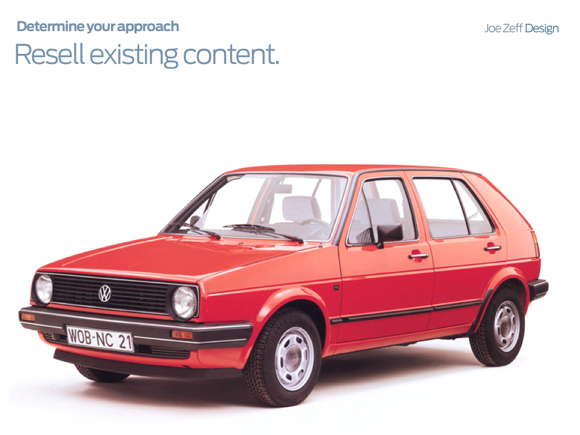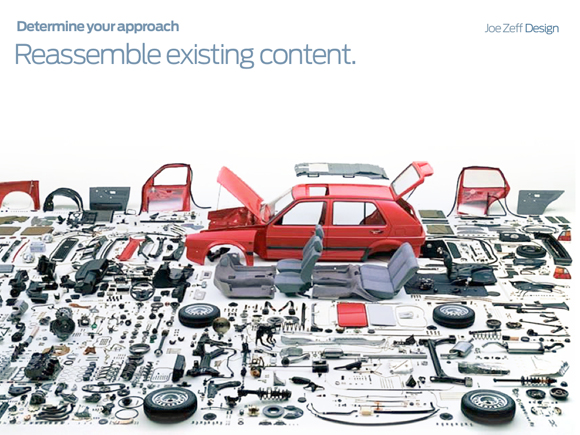In Defense of Tablet Publishing
The death of The Daily has called into question the viability of iPad apps as a way to deliver magazine content. "Tablets in general, and the iPad in particular, are actually much less powerful and revolutionary than many of us had hoped," writes Felix Salmon of Reuters. "Turds all around," adds MG Siegler of TechCrunch.
Has digital publishing on iPad jumped the shark?
Not if done right.
Why Apps Fail
Simply put:
• The numbers don't add up. To borrow John Gruber's math, $25 million out and $4 million in was too much for an embattled News Corp. to absorb.
• They're unwieldy. The Daily was clumsy to download, clumsy to navigate.
• They're not special enough. The Daily's content was no better than what you could get elsewhere.
How Yours Won't
• Make the numbers work. Understand your specific goals, and what you're willing to pay to achieve them.
In some cases, that goal is revenue. Recognize that it may take time for your investment to pay off, as more consumers buy tablets and shift consumption habits. Certainly Rupert Murdoch didn't expect to make his entire $25 million back in one year. But he also didn't fully exploit the potential for advertising revenues to offset subscription costs. Charge less for your product in order to put it in front of more eyeballs. That creates a more attractive vehicle for advertisers and sponsors willing to pay for large, targeted audiences.
In other cases, that goal is exposure. The value of marketing buzz can be hard to quantify, but a perfectly acceptable reason for launching an app — with or without a potential revenue stream. An app that does not generate revenues can still deliver goodwill or brand currency that adds value to other products or initiatives. That's not losing money — that's investing money. And money well spent if the value it adds to your brand outweighs the development costs of the app. Apps that are forward-thinking can help define the brands they represent as forward-thinking as well.
• Make it wieldy. The smaller the better, which helps to make it easier to navigate. Instead of piling every article from a magazine into a bloated app, consider putting it into several issues and selling the content a la carte, which would reduce file sizes to more manageable levels. We prescribed this years ago, and very few publishers have taken the bait. Another option, as Craig Mod points out in a well-circulated manifesto called "Subcompact Publishing.": Turn monthlies into weeklies, to engage consumers on a more frequent basis with content that is more accessible.
Here's a post from our blog called "Think Incrementally" that came out a week before the first iPad reached stores. It is just as relevant today as it was on March 24, 2010.
• Make it special. Here's where we differ with the bloggers who are rushing to coronate The Magazine as the model for digital publishing. The Magazine, for all of its efficiencies, is not special. It is an app that contains predictably formatted text on predictably formatted pages. The text on the pages is special, but its delivery is not. Magazines have the potential to interact with consumers on so many more levels, using combinations of text, photos and multimedia that create an experience. The Magazine is a dressed up RSS feed that could be just as effective on the web. It does not demonstrate the potential for magazines, or the iPad, because it lacks the one ingredient that makes magazines special: spontaneity. Excite the user and they'll come back again and again to see what surprises come next.
The future of magazines? You decide.
Native apps vs. DPS apps vs. websites
Many of the bloggers cited above fixate on the platforms by which apps are made. There is Adobe Digital Publishing Suite (DPS), which allows designers to build apps that minimize programming by leveraging a WYSIWYG platform that contains a library of pre-built functionality. There are native apps, built the old-fashioned way with programmers and code that delivers specific results. And there are websites, accessible by anyone and everyone, regardless of whether they have a fancy tablet.
Felix Salmon favors the web: "There’s almost nothing you can do well on a tablet that you can’t just put on a website and ask people to read in a browser."
We disagree.
• Web content requires an Internet connection. Apps can be configured to work without Internet, forcing the consumer to download content onto their device. Many users access apps on the go, and these apps work regardiless of connectivity. Download times suck, but so do unserved web pages. Pick your battles.
• Web content is harder to monetize. Publishers can collect single-copy and subscription fees much more easily using the iTunes App Store than by using web standards like credit card forms and PayPal redirects. Yes, Apple takes a hefty cut. But PayPal and other web standards aren't free either. Until that changes, apps yield effortless transactions and more impulse buys.
• Web content is constrained by programming. Again, it comes down to spontaneity. Typically there's a programmer inserted between the content creator and the content consumer on the web. Using DPS, that's not the case. The content creator is able to deliver ideas and information without the need for a programmer, and the original intent of the content is less likely to get lost in translation. The compromise for those building native apps, more often than not, is a content management system that imposes strict rules on the content creator that constrains their ability to be spontaneous. Using DPS, we can inject HTML where it makes sense to make apps better.
DPS isn't the problem. It's a solution, allowing content providers to deliver digital magazines in a fraction of the time that it takes to produce native applications.
The problem is the short-sighted approach that the publishing industry has taken toward digital magazines.
The Audit Bureau of Circulations is the organization that certifies how many people read specific magazines, so that publishers can charge advertisers rates that are based on verified circulation numbers. Many publishers see the iPad and other tablets as a way to increase those numbers. Digital magazines are included in those circulation figures if a publisher plays by ABC rules, which specifiy that every word and image of every print issue must be replicated in its digital edition in order to count.
We cautioned publishers against a replica-only strategy. In a blog post called "Reinventing Your Publication for the Tablet," based on a presentation given at the WoodWing World Tour in San Francisco in March 2011, we specified four strategies that publishers could deploy:
Publishers are much better off creating new products built from the ground up to leverage new opportunities, and some of those new opportunities may involve leveraging existing content. We worked with Ziff-Davis, which shut down the print edition of PC Magazine a few years back, to resuscitate its valuable brand as a digital magazine that has won raves. Earlier today we launched a digital magazine for Kids Discover, a print franchise started in 1991, that simply wouldn't be possible as a website or native app, given the monthly publication schedule and the need to inject spontaneity to make the content appealing to children. Both of these products demonstrate the potential for digital publishing on the iPad to engage audiences that have tired of print.
It's easy to hurl turds. It's harder to come up with ways to capitalize on these new opportunities. We remain convinced that digital publishing through apps will continue to thrive. As more people consume content on iPads and iPhones, there is increasing value in delivering content that is best-suited to those devices. It's all about strategies, and how innovation can help those strategies succeed.
Learn more about Joe Zeff Design • See all of our apps • Subscribe to this blog







